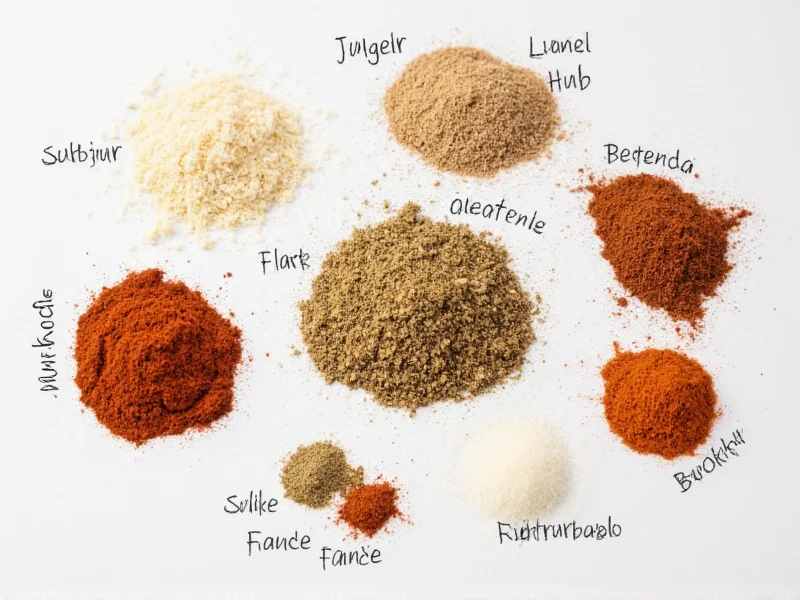Choosing the right spices transforms simple baked chicken from bland to extraordinary. The magic happens when you understand how different seasonings interact with poultry's mild flavor profile. Chicken acts as a perfect canvas for spices, absorbing flavors while maintaining its delicate texture when baked properly. This guide reveals professional techniques for creating restaurant-quality baked chicken using accessible spices you likely already have in your pantry.
Essential Spices for Baked Chicken
Understanding individual spices helps you create custom blends tailored to your taste preferences. Each spice contributes unique flavor compounds that interact differently with chicken's proteins during the baking process.
Paprika
This versatile spice provides both color and flavor depth. Sweet paprika offers mild pepper notes, while smoked paprika adds a complex, barbecue-like dimension. Hungarian paprika brings earthy warmth. For baked chicken, use 1-2 teaspoons per pound to achieve rich color without bitterness. Paprika contains capsaicinoids that bind well with chicken's fat content, creating long-lasting flavor.
Garlic Powder
Unlike fresh garlic, garlic powder distributes evenly and won't burn during baking. Its allicin compounds react with chicken proteins to create savory umami notes. Use 1-1.5 teaspoons per pound for balanced flavor. Avoid garlic salt to control sodium levels precisely—this is crucial for healthy seasoning for baked chicken that doesn't compromise taste.
Dried Herbs: Thyme, Rosemary, Oregano
These Mediterranean herbs contain volatile oils that withstand baking temperatures. Thyme offers subtle lemon notes, rosemary provides pine-like complexity, and oregano delivers earthy warmth. Combine them in equal parts (1 teaspoon total per pound of chicken) for authentic Mediterranean spices for baked chicken. Fresh herbs burn easily in the oven, making dried versions ideal for this application.
Proven Spice Combinations for Baked Chicken
Creating balanced spice rubs requires understanding flavor chemistry. The following tested combinations deliver restaurant-quality results with precise measurements—essential for those wondering how much spice to use on chicken.
| Flavor Profile | Spice Blend (per pound of chicken) | Best Pairings |
|---|---|---|
| Classic Herb | 1 tsp dried thyme, 1 tsp dried rosemary, 1/2 tsp dried marjoram, 1 tsp garlic powder, 1/2 tsp onion powder | Lemon wedges, roasted potatoes, green beans |
| Smoky Southwest | 1 tbsp smoked paprika, 1 tsp cumin, 1/2 tsp chili powder, 1/2 tsp garlic powder, 1/4 tsp cayenne | Corn salsa, black beans, avocado |
| Lemon Pepper | 2 tsp lemon zest, 1 tsp cracked black pepper, 1 tsp garlic powder, 1/2 tsp onion powder, 1/2 tsp dried dill | Asparagus, wild rice, cherry tomatoes |
| Middle Eastern | 1 tsp ground cumin, 1 tsp ground coriander, 1/2 tsp turmeric, 1/2 tsp sumac, 1/4 tsp cinnamon | Couscous, roasted carrots, tahini sauce |
Application Techniques for Maximum Flavor
Knowing when to apply spices to chicken before baking significantly impacts results. Follow these professional techniques:
Dry Brining Method
Combine salt with your spice blend and apply to chicken 1-24 hours before cooking. The salt draws out moisture, which then reabsorbs along with spices, seasoning the meat throughout. This technique works exceptionally well for spice rub for baked chicken on bone-in pieces. Refrigerate uncovered during this process to dry the skin for optimal crispness.
Oil-Based Paste
Mix spices with 1-2 teaspoons of olive oil per pound of chicken to create a paste. The oil helps spices adhere and carries fat-soluble flavor compounds into the meat. Apply 30-60 minutes before baking—any longer and acidic components might begin to cook the surface. This method works best for quick spice mix for baked chicken when time is limited.
Avoid Common Seasoning Mistakes
- Burning spices: Avoid applying sugar-containing blends (like many commercial seasonings) too early in baking
- Uneven distribution: Measure spices precisely rather than eyeballing for consistent results
- Over-salting: Remember that salt quantity should adjust based on other salty ingredients in your recipe
- Ignoring resting time: Allow seasoned chicken to sit 20-30 minutes at room temperature before baking for even cooking
Regional Variations for Global Flavors
Explore international flavor combinations for baked chicken with these authentic approaches:
Mediterranean Approach
Greek and Italian preparations use lemon juice with oregano and garlic. For authentic results, add lemon juice after baking to preserve its bright flavor. The acid would otherwise tighten chicken proteins if applied too early. This technique creates the perfect best spices for baked chicken breasts with lean cuts.
Middle Eastern Za'atar Blend
This traditional mix combines thyme, sumac, and sesame seeds. Sumac's tartness mimics lemon without moisture issues during baking. Use 1.5 tablespoons za'atar per pound of chicken with 1 teaspoon olive oil. This homemade chicken seasoning blend works particularly well with chicken thighs.
Latin American Adobo
Combine cumin, garlic powder, oregano, and achiote for authentic flavor. Achiote provides color without significant heat. For best results with this spice rub for baked chicken, include a small amount of vinegar in your oil mixture to help the spices adhere and tenderize the meat.
Storage and Freshness Tips
Spice potency dramatically affects results. Ground spices lose 50% of their volatile oils within 6 months. Store blends in airtight containers away from light and heat. For how to season chicken before baking with maximum impact, refresh your spice cabinet every 6-12 months. Test older spices by rubbing a small amount between your fingers—if the aroma is weak, it's time to replace them.
Pre-mixed dry rubs can be stored for 2-3 months, while oil-based pastes should be used within 3 days. Freeze herb-based blends in ice cube trays with olive oil for longer storage without flavor degradation.











 浙公网安备
33010002000092号
浙公网安备
33010002000092号 浙B2-20120091-4
浙B2-20120091-4